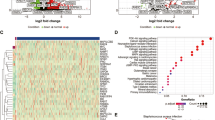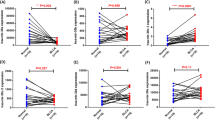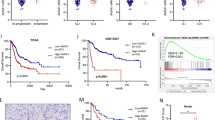Abstract
Purpose
This research intended to explore the effect of FLNA on cell proliferation, invasion and migration in bladder carcinoma (BC).
Methods
Microarray analysis was performed with the TCGA data, and the results were confirmed on 20 paired BC tissues and adjacent tissues using qRT-PCR and immunohistochemistry. Transmission electron microscope (TEM) and cell fluorescence assay were used to observe the quantity of autophagosomes. The expression of autophagy-related protein (LC3-I/II, p62) was detected by western blot. Cell proliferation was detected using CCK-8 and colony formation. The invasion and migration ability of the cell were tested by transwell and wound-healing assay. Tumor xenograft in BALB/c nude mice and HE staining were utilized to probe into the effects of FLNA-induced regulation of volume, weight and metastasis of tumors.
Results
We confirmed that FLNA was down-regulated in BC tissues. TEM and fluorescence analysis proved that FLNA overexpression promoted autophagy in BC cells. Colony formation assay and CCK-8 experiment showed that FLNA overexpression suppressed the proliferation of BC cells. In addition, FLNA blocked cell cycle and promoted apoptosis of BC cell. Transwell assay and wound-healing assay further proved that FLNA suppressed invasion and migration ability in BC cell. Meanwhile, in vivo study indicated that FLNA inhibited the tumor growth.
Conclusion
Overexpression of FLNA suppressed the proliferation, migration and invasion of the BC cell, suggesting the potential role of FLNA in clinical treatment.






Similar content being viewed by others
References
Siegel RL, Miller KD, Jemal A (2016) Cancer statistics. CA Cancer J Clin 66(1):7–30. https://doi.org/10.3322/caac.21332
Song Y, Zhang P, Sun Y, Li X, Chen L, Xiao Y, Xing Y (2017) AMPK activation-dependent autophagy compromises oleanolic acid-induced cytotoxicity in human bladder cancer cells. Oncotarget 8(40):67942–67954. https://doi.org/10.18632/oncotarget.18980
Miller KD, Siegel RL, Lin CC, Mariotto AB, Kramer JL, Rowland JH, Stein KD, Alteri R, Jemal A (2016) Cancer treatment and survivorship statistics. CA Cancer J Clin 66(4):271–289. https://doi.org/10.3322/caac.21349
Kamat AM, Hahn NM, Efstathiou JA, Lerner SP, Malmstrom PU, Choi W, Guo CC, Lotan Y, Kassouf W (2016) Bladder cancer. Lancet 388(10061):2796–2810. https://doi.org/10.1016/S0140-6736(16)30512-8
Song M, He Q, Berk BA, Hartwig JH, Stossel TP, Nakamura F (2016) An adventitious interaction of filamin A with RhoGDI2(Tyr153Glu). Biochem Biophys Res Commun 469(3):659–664. https://doi.org/10.1016/j.bbrc.2015.12.044
Krebs K, Ruusmann A, Simonlatser G, Velling T (2015) Expression of FLNa in human melanoma cells regulates the function of integrin alpha1beta1 and phosphorylation and localisation of PKB/AKT/ERK1/2 kinases. Eur J Cell Biol 94(12):564–575. https://doi.org/10.1016/j.ejcb.2015.10.006
Shao QQ, Zhang TP, Zhao WJ, Liu ZW, You L, Zhou L, Guo JC, Zhao YP (2016) Filamin A: insights into its exact role in cancers. Pathol Oncol Res 22(2):245–252. https://doi.org/10.1007/s12253-015-9980-1
Sun GG, Lu YF, Zhang J, Hu WN (2014) Filamin A regulates MMP-9 expression and suppresses prostate cancer cell migration and invasion. Tumour Biol 35(4):3819–3826. https://doi.org/10.1007/s13277-013-1504-6
Sun GG, Sheng SH, Jing SW, Hu WN (2014) An antiproliferative gene FLNA regulates migration and invasion of gastric carcinoma cell in vitro and its clinical significance. Tumour Biol 35(3):2641–2648. https://doi.org/10.1007/s13277-013-1347-1
Ruppen I, Grau L, Orenes-Pinero E, Ashman K, Gil M, Algaba F, Bellmunt J, Sanchez-Carbayo M (2010) Differential protein expression profiling by iTRAQ-two-dimensional LC-MS/MS of human bladder cancer EJ138 cells transfected with the metastasis suppressor KiSS-1 gene. Mol Cell Proteomics 9(10):2276–2291. https://doi.org/10.1074/mcp.M900255-MCP200
Zeng Q, Liu J, Cao P, Li J, Liu X, Fan X, Liu L, Cheng Y, Xiong W, Li J, Bo H, Zhu Y, Yang F, Hu J, Zhou M, Zhou Y, Zou Q, Zhou J, Cao K (2017) Inhibition of REDD1 sensitizes bladder urothelial carcinoma to paclitaxel by inhibiting autophagy. Clin Cancer Res. https://doi.org/10.1158/1078-0432.CCR-17-0419
Ulbricht A, Eppler FJ, Tapia VE, van der Ven PF, Hampe N, Hersch N, Vakeel P, Stadel D, Haas A, Saftig P, Behrends C, Furst DO, Volkmer R, Hoffmann B, Kolanus W, Hohfeld J (2013) Cellular mechanotransduction relies on tension-induced and chaperone-assisted autophagy. Curr Biol CB 23(5):430–435. https://doi.org/10.1016/j.cub.2013.01.064
Yin H, Yang X, Gu W, Liu Y, Li X, Huang X, Zhu X, Tao Y, Gou X, He W (2017) HMGB1-mediated autophagy attenuates gemcitabine-induced apoptosis in bladder cancer cells involving JNK and ERK activation. Oncotarget 8(42):71642–71656. https://doi.org/10.18632/oncotarget.17796
Yu G, Jia Z, Dou Z (2017) miR-24-3p regulates bladder cancer cell proliferation, migration, invasion and autophagy by targeting DEDD. Oncol Rep 37(2):1123–1131. https://doi.org/10.3892/or.2016.5326
Hewitt G, Carroll B, Sarallah R, Correia-Melo C, Ogrodnik M, Nelson G, Otten EG, Manni D, Antrobus R, Morgan BA, von Zglinicki T, Jurk D, Seluanov A, Gorbunova V, Johansen T, Passos JF, Korolchuk VI (2016) SQSTM1/p62 mediates crosstalk between autophagy and the UPS in DNA repair. Autophagy 12(10):1917–1930. https://doi.org/10.1080/15548627.2016.1210368
Xu Y, Bismar TA, Su J, Xu B, Kristiansen G, Varga Z, Teng L, Ingber DE, Mammoto A, Kumar R, Alaoui-Jamali MA (2010) Filamin A regulates focal adhesion disassembly and suppresses breast cancer cell migration and invasion. J Exp Med 207(11):2421–2437. https://doi.org/10.1084/jem.20100433
Zhang K, Zhu T, Gao D, Zhang Y, Zhao Q, Liu S, Su T, Bernier M, Zhao R (2014) Filamin A expression correlates with proliferation and invasive properties of human metastatic melanoma tumors: implications for survival in patients. J Cancer Res Clin Oncol 140(11):1913–1926. https://doi.org/10.1007/s00432-014-1722-3
Wieczorek K, Wiktorska M, Sacewicz-Hofman I, Boncela J, Lewinski A, Kowalska MA, Niewiarowska J (2017) Filamin A upregulation correlates with snail-induced epithelial to mesenchymal transition (EMT) and cell adhesion but its inhibition increases the migration of colon adenocarcinoma HT29 cells. Exp Cell Res 359(1):163–170. https://doi.org/10.1016/j.yexcr.2017.07.035
Savoy RM, Ghosh PM (2013) The dual role of filamin A in cancer: can’t live with (too much of) it, can’t live without it. Endocr Relat Cancer 20(6):R341–R356. https://doi.org/10.1530/ERC-13-0364
Buffen K, Oosting M, Quintin J, Ng A, Kleinnijenhuis J, Kumar V, van de Vosse E, Wijmenga C, van Crevel R, Oosterwijk E, Grotenhuis AJ, Vermeulen SH, Kiemeney LA, van de Veerdonk FL, Chamilos G, Xavier RJ, van der Meer JW, Netea MG, Joosten LA (2014) Autophagy controls BCG-induced trained immunity and the response to intravesical BCG therapy for bladder cancer. PLoS Pathog 10(10):e1004485. https://doi.org/10.1371/journal.ppat.1004485
King MA, Ganley IG, Flemington V (2016) Inhibition of cholesterol metabolism underlies synergy between mTOR pathway inhibition and chloroquine in bladder cancer cells. Oncogene 35(34):4518–4528. https://doi.org/10.1038/onc.2015.511
Zhang S, Jiang S, Wang H, Di W, Deng C, Jin Z, Yi W, Xiao X, Nie Y, Yang Y (2017) SIRT6 protects against hepatic ischemia/reperfusion injury by inhibiting apoptosis and autophagy related cell death. Free Radic Biol Med 115:18–30. https://doi.org/10.1016/j.freeradbiomed.2017.11.005
Ai J, Huang H, Lv X, Tang Z, Chen M, Chen T, Duan W, Sun H, Li Q, Tan R, Liu Y, Duan J, Yang Y, Wei Y, Li Y, Zhou Q (2011) FLNA and PGK1 are two potential markers for progression in hepatocellular carcinoma. Cell Physiol Biochem 27(3–4):207–216. https://doi.org/10.1159/000327946
Acknowledgements
We sincerely acknowledge the support from Key Discipline Medicine of Jiangsu Province (201151) XK 201151.
Funding
This study was supported by Key Discipline Medicine of Jiangsu Province (201151) XK 201151.
Author information
Authors and Affiliations
Contributions
JP was involved in protocol/project development. CL and MJ performed data collection or management. JC and MY contributed to data analysis. ZW edited and wrote the manuscript. All authors contributed to the final approval of this manuscript.
Corresponding author
Ethics declarations
Conflict of interest
The authors declare that they have no conflict of interest.
Ethical approval and informed consent
This study was approved by the Ethics Committee of the First Affiliated Hospital of Soochow University, and written informed consent was obtained from all participants.
Rights and permissions
About this article
Cite this article
Wang, Z., Li, C., Jiang, M. et al. Filamin A (FLNA) regulates autophagy of bladder carcinoma cell and affects its proliferation, invasion and metastasis. Int Urol Nephrol 50, 263–273 (2018). https://doi.org/10.1007/s11255-017-1772-y
Received:
Accepted:
Published:
Issue Date:
DOI: https://doi.org/10.1007/s11255-017-1772-y




